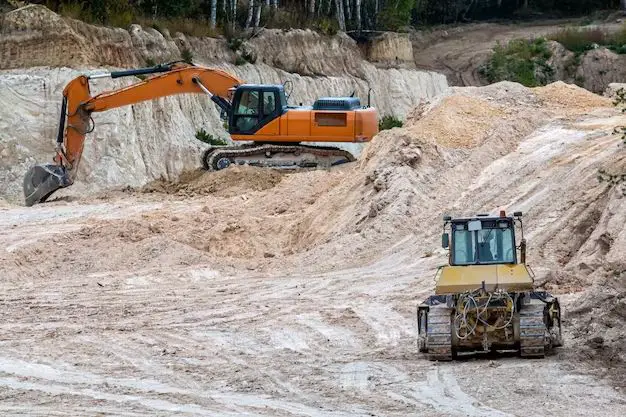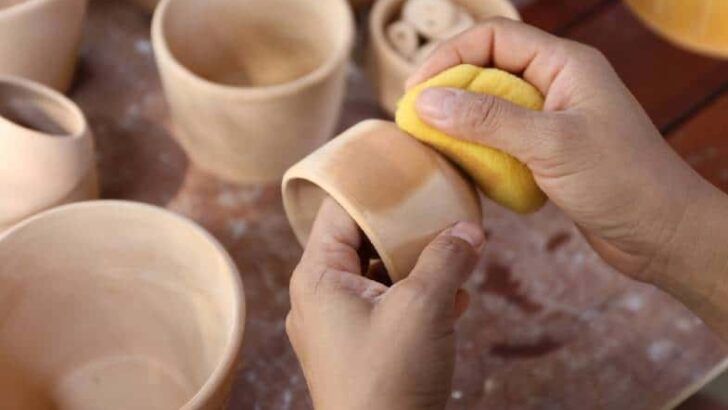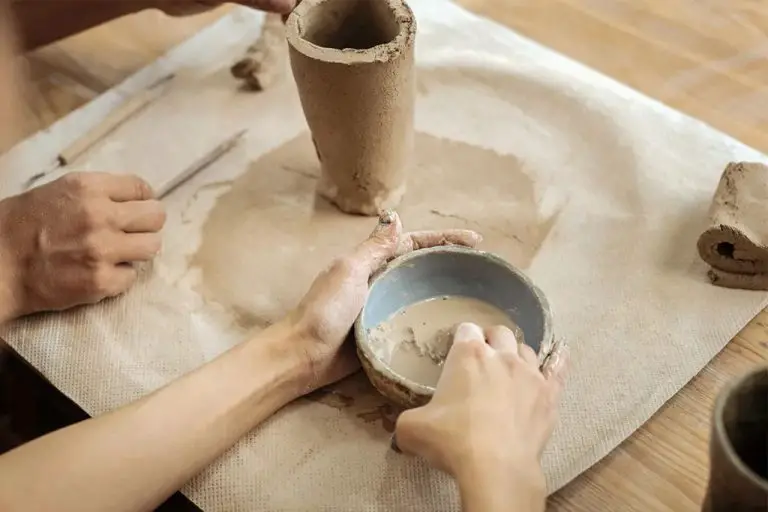How Many Pounds Of Clay Do I Need To Throw A Pitcher?
When creating pottery on the wheel, determining how much clay you need is an important first step. The amount of clay required depends on several factors, especially the size and style of the piece you want to throw. For functional pieces like pitchers, mugs, and bowls, the general size and shape will dictate how much clay is needed.
There are also other elements that impact clay quantity. The skill level and experience of the potter can change how much clay goes into a piece. Beginners often need more clay to allow for mistakes and issues while throwing. The type of clay used also makes a difference. More porous clays may require thicker walls and therefore more clay volume.
This article will walk through estimating how much clay is required to throw a basic pitcher on the pottery wheel. We’ll look at guidelines for different pitcher sizes, factoring in skill level, adding extra clay, and other considerations when determining clay needs.
Choosing Clay Type
The type of clay you choose for throwing a pitcher is an important first step. Clay comes in different varieties, each with their own properties that affect the throwing and firing process. Here are some of the main options:
Stoneware Clay – Stoneware clays are very strong and durable when fired to a high temperature. They have good plasticity which makes them easy to throw and shape. Stoneware has low porosity and resists water absorption, making it suitable for functional pieces like pitchers. However, stoneware requires higher firing temperatures (2200°F – 2400°F).
Earthenware Clay – Earthenware clays are very plastic and easy to work with when throwing on the wheel. They fire at lower temperatures than stoneware (1800°F – 2100°F). However, earthenware is much more porous and absorbs water easily, so it may not be the best choice for a liquid-holding pitcher unless the clay body has been formulated specifically for functionality.
Porcelain – Porcelain clays are very fine and smooth with excellent plasticity. This makes them a great choice for throwing thin-walled vessels. Porcelain is fired at very high temperatures (up to 2400°F) and becomes vitrified, resulting in low porosity, high strength, and translucency. The downside is that porcelain can be prone to warping and cracking during drying and firing if not handled properly.
Consider testing out a few clay types to decide which one throws the best for your skill level and has the properties you want for making a functional pitcher that holds liquid well after firing. Porcelain and stoneware are good choices if you want a strong, durable pitcher.
Determining Pitcher Size
When determining how much clay you need, first decide on the desired size for your pitcher. Consider if you want to make a small 8-10 ounce pitcher for single servings or a larger 34-64 ounce pitcher for multiple servings or for display. Standard pitcher sizes include:
- 8 ounces
- 12 ounces
- 16 ounces
- 32 ounces
- 64 ounces
Measuring out the dimensions with a ruler on paper or in a modeling clay prototype can help you visualize the size. Small pitchers around 8-12 ounces are typically 4-5 inches tall and 3-4 inches wide. Larger pitchers around 64 ounces may be 10-12 inches tall and 5-6 inches wide.
Consider the intended use and personal preferences when deciding on a size. A smaller pitcher will use less clay while a larger display piece makes more of an impression. Standard sizes based on drink servings provide a useful starting point.
Calculating Clay Needed for Different Sizes
The amount of clay needed will vary based on the size of the pitcher you want to throw. Here are some estimates for small, medium and large pitchers:
Small Pitcher
For a small pitcher around 6-8 inches tall, you will need approximately 1-2 lbs of clay. This will give you enough clay to throw the basic form while leaving some extra to adjust the shape or add decorative elements.
Medium Pitcher
For a medium sized pitcher around 8-12 inches tall, plan on using 2-3 lbs of clay. The extra clay allows you to create more intricate shapes and details on a larger form.
Large Pitcher
For large pitchers 12 inches or taller, you will want 3-5 lbs of clay. Large pieces require more clay for stability and to have enough to work with for shaping and detailing the final form.
Keep in mind the size estimates above are general guidelines. The exact amount can vary based on the thickness of the walls, shape and other design elements.
Factor In Skill Level
The amount of clay required can vary depending on the skill level of the potter. Beginners tend to use more clay than necessary when throwing a pitcher. They might add extra clay in case mistakes are made or the pitcher collapses. The added clay acts as a buffer. Beginners also often make the walls of the pitcher thicker than needed for structural integrity.
Intermediate potters have more experience and efficiency throwing pitchers. They know how much clay is needed and don’t overcompensate with extras. The pitcher walls will be an appropriate thickness. Less clay goes to waste. An intermediate potter needs about 25% less clay than a beginner for the same size pitcher.
Adding Extra Clay
When calculating how much clay you need to throw a pitcher, it’s important to add extra clay beyond the base amount. Here are some reasons why:
Practice throws – Even experienced potters need to practice throwing a new shape or size several times before they master it. Having extra clay allows you to throw the pitcher a few times to refine the process before committing to the final version.
Defects – No matter how carefully you work, some pitchers will end up with defects like cracks, dents, or uneven shapes. Extra clay gives you a buffer so you can re-throw if the first try doesn’t turn out perfectly.
Spills and unused clay – Bits of clay may drop on the floor or get left behind on your tools or work surface. Having extra ensures you don’t run short even accounting for these small losses.
Test glazes – If you plan to experiment with different glaze techniques, you may want to throw a few extra pitchers as test pieces. Extra clay allows for this without limiting your final pitcher.
For most beginning-intermediate potters, adding about 10-20% onto the base amount is reasonable. So if you calculate you need 2 pounds of clay, get 2.2-2.4 pounds. Advanced potters can likely get away with less extra. But it’s always better to have more clay than you need versus not enough to finish your piece!
Special Considerations
When throwing a pitcher, there are some special considerations that may require using more clay than the basic calculations above.
If you plan to make a very large or heavy pitcher, you will likely need to use more clay than estimated. Large pitchers that hold a lot of liquid weight require thicker walls and base. Sculpting those elements to be sturdier for heavy use requires additional clay.
Creating pitchers in unique or intricate shapes will also require more clay. Making elaborate handles, spouts, textures, or other decorative elements on the pitcher adds to the total amount of clay needed.
The skill level of the potter can also impact how much clay is ideal to have on hand when throwing a pitcher. Beginners tend to use more clay since their throwing skills are not as refined. Having extra clay allows beginners to remake sections if needed without running out of material.
Clay Storage
Properly storing your leftover clay is crucial for maintaining its ideal consistency and workability. Here are some tips for storing unused clay:
- Wrap clay in plastic wrap or place it in an airtight plastic bag, squeezing out excess air. This prevents the clay from drying out.
- Store clay in a cool, dry place like a basement or cupboard. Avoid warm areas like on top of the refrigerator. Consistent room temperature is ideal.
- For longer storage, consider freezing clay. Let it thaw completely before reusing.
- If clay does start to dry out, rehydrate it by kneading in some water. Start with just a teaspoon at a time to avoid over-softening.
- To reuse clay that has fully dried into a solid block, break it up and soak it in water overnight. Then knead it vigorously to work the moisture back in evenly.
With proper storage, clay can last for months while retaining its smooth, supple texture. Just be sure to keep it sealed airtight in plastic, stored cool and dry. Add water as needed to rehydrate clay before throwing your next masterpiece.
Throwing the Pitcher
Once you have the necessary amount of clay weighed out and wedged, it’s time to start throwing the pitcher. The basic process involves centering the clay on the wheel and pulling it up into the desired shape.
To center the clay, form it into a ball and slam it down onto the center of the wheel. Apply pressure while the wheel spins to form it into a cylinder. Use your fingers and some water to smooth the sides and compress any air bubbles.
When centering is complete, stop the wheel and open the clay into the shape you want for the bottom of the pitcher. Then restart the wheel and use your hands to gradually pull the walls up and out to the desired height, smoothing as you go. Take care to maintain an even thickness throughout.
Applying gentle pressure on the inside and outside while pulling up the clay will help achieve the right shape. Pulling too quickly or aggressively can cause the sides to collapse. Stop periodically to compress and smooth the surface.
Once the basic shape is formed, refine the lip, add handles or a spout if desired, and allow your pitcher to stiffen slightly before trim and finishing.
Summary
When determining how much clay you need to throw a pitcher, there are a few key factors to consider:
– The type of clay – Stoneware and porcelain require different amounts. Porcelain is denser and needs more clay.
– The size and style of the pitcher – A larger pitcher will require substantially more clay than a small one. Complex styles with handles and spouts also use more clay.
– Your skill level – Beginners will want extra clay to allow for mistakes. Experienced potters can work with less.
It’s always best to start with more clay than you think you’ll need. Adding an extra 20-30% above the base amount gives you plenty of room for throwing errors and for trimming the final piece. You can recycle any unused clay afterward.
The most important thing is to weigh out an appropriate amount for the project before you begin. Take your time centering and shaping to avoid wasting clay. With practice, you’ll get better at estimating how much you really require.




